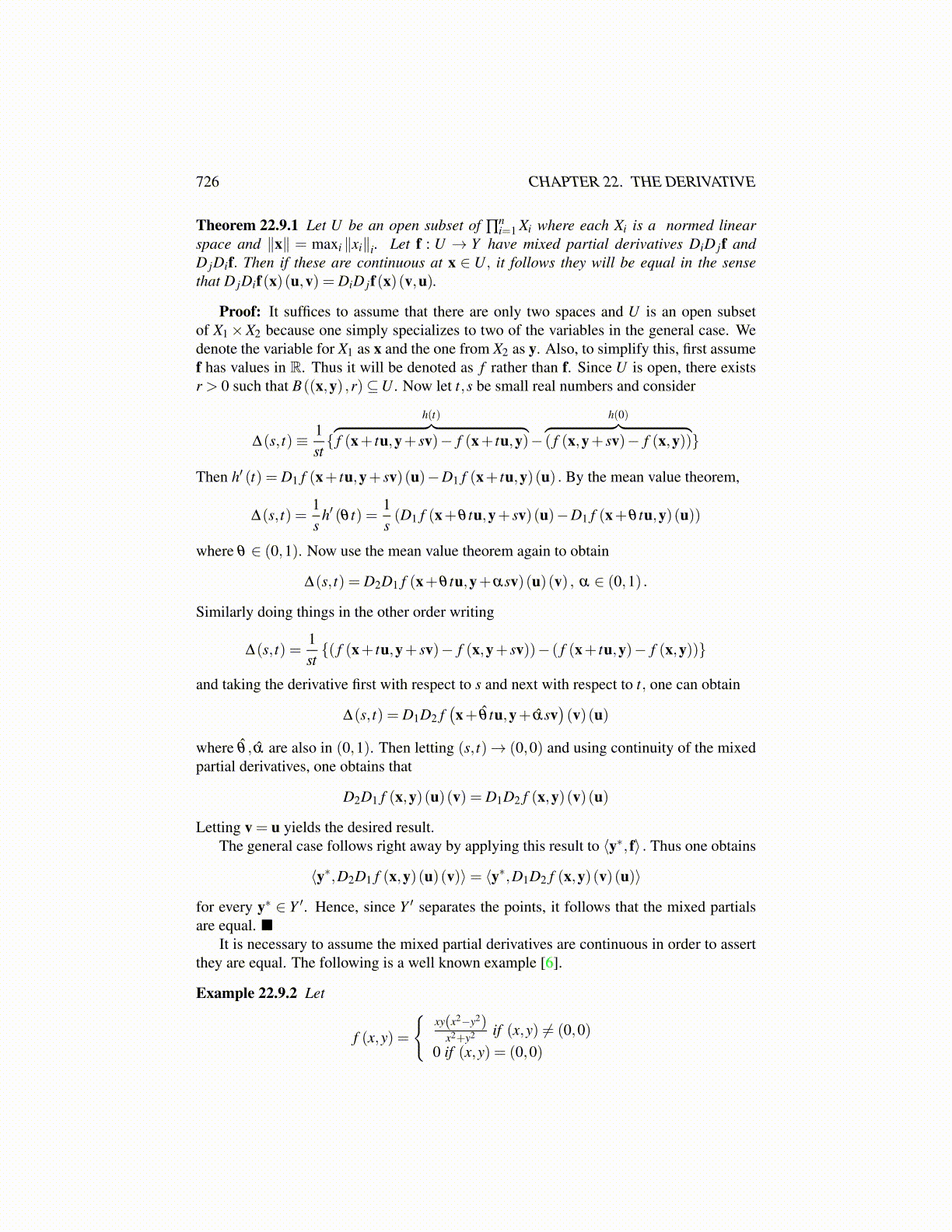
726 CHAPTER 22. THE DERIVATIVE
Theorem 22.9.1 Let U be an open subset of ∏ni=1 Xi where each Xi is a normed linear
space and ∥x∥ = maxi ∥xi∥i. Let f : U → Y have mixed partial derivatives DiD jf andD jDif. Then if these are continuous at x ∈ U, it follows they will be equal in the sensethat D jDif(x)(u,v) = DiD jf(x)(v,u).
Proof: It suffices to assume that there are only two spaces and U is an open subsetof X1×X2 because one simply specializes to two of the variables in the general case. Wedenote the variable for X1 as x and the one from X2 as y. Also, to simplify this, first assumef has values in R. Thus it will be denoted as f rather than f. Since U is open, there existsr > 0 such that B((x,y) ,r)⊆U . Now let t,s be small real numbers and consider
∆(s, t)≡ 1st{
h(t)︷ ︸︸ ︷f (x+ tu,y+ sv)− f (x+ tu,y)−
h(0)︷ ︸︸ ︷( f (x,y+ sv)− f (x,y))}
Then h′ (t) = D1 f (x+ tu,y+ sv)(u)−D1 f (x+ tu,y)(u) . By the mean value theorem,
∆(s, t) =1s
h′ (θ t) =1s(D1 f (x+θ tu,y+ sv)(u)−D1 f (x+θ tu,y)(u))
where θ ∈ (0,1). Now use the mean value theorem again to obtain
∆(s, t) = D2D1 f (x+θ tu,y+αsv)(u)(v) , α ∈ (0,1) .
Similarly doing things in the other order writing
∆(s, t) =1st{( f (x+ tu,y+ sv)− f (x,y+ sv))− ( f (x+ tu,y)− f (x,y))}
and taking the derivative first with respect to s and next with respect to t, one can obtain
∆(s, t) = D1D2 f(x+ θ̂ tu,y+ α̂sv
)(v)(u)
where θ̂ , α̂ are also in (0,1). Then letting (s, t)→ (0,0) and using continuity of the mixedpartial derivatives, one obtains that
D2D1 f (x,y)(u)(v) = D1D2 f (x,y)(v)(u)
Letting v = u yields the desired result.The general case follows right away by applying this result to ⟨y∗, f⟩ . Thus one obtains
⟨y∗,D2D1 f (x,y)(u)(v)⟩= ⟨y∗,D1D2 f (x,y)(v)(u)⟩
for every y∗ ∈ Y ′. Hence, since Y ′ separates the points, it follows that the mixed partialsare equal.
It is necessary to assume the mixed partial derivatives are continuous in order to assertthey are equal. The following is a well known example [6].
Example 22.9.2 Let
f (x,y) =
{xy(x2−y2)
x2+y2 if (x,y) ̸= (0,0)0 if (x,y) = (0,0)